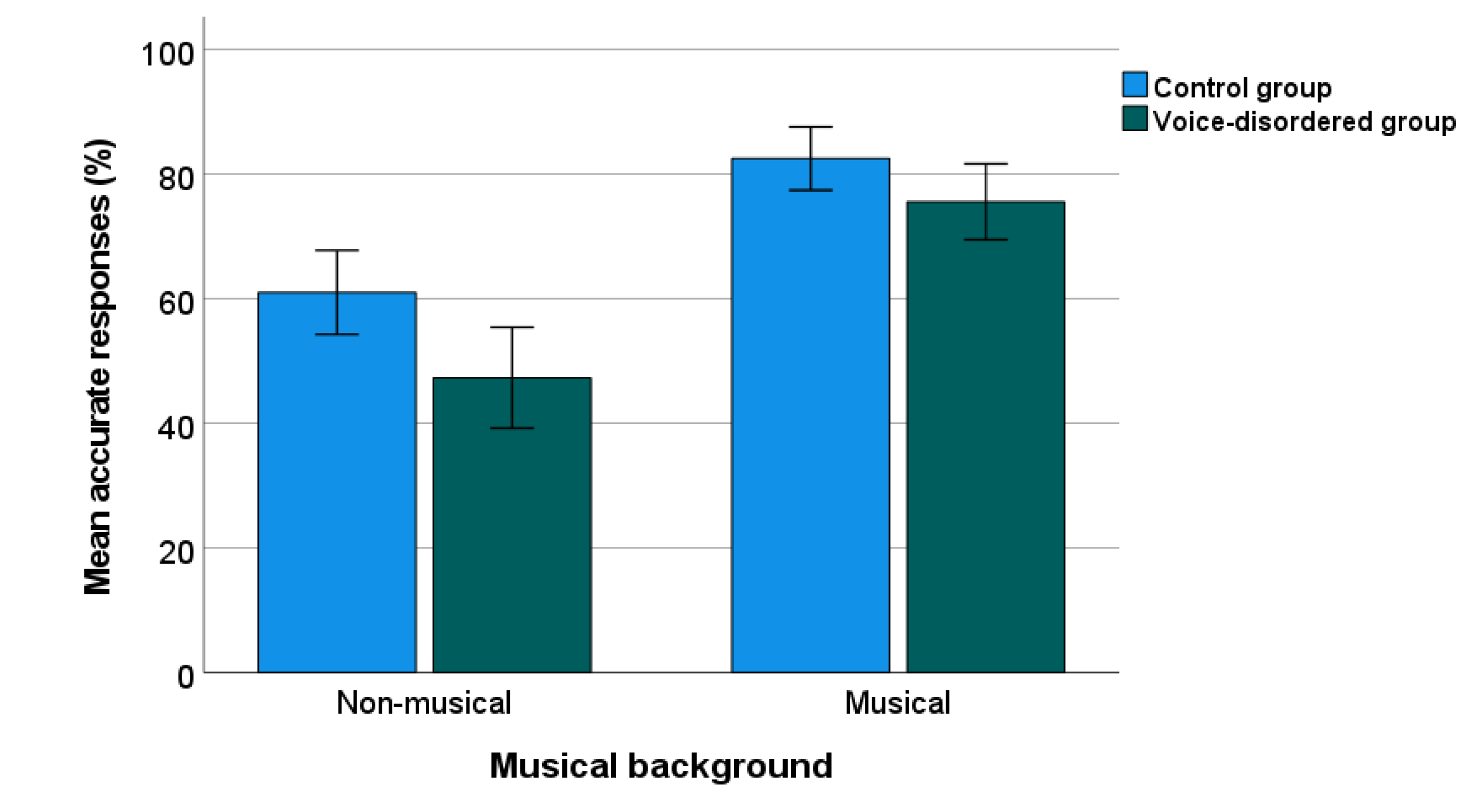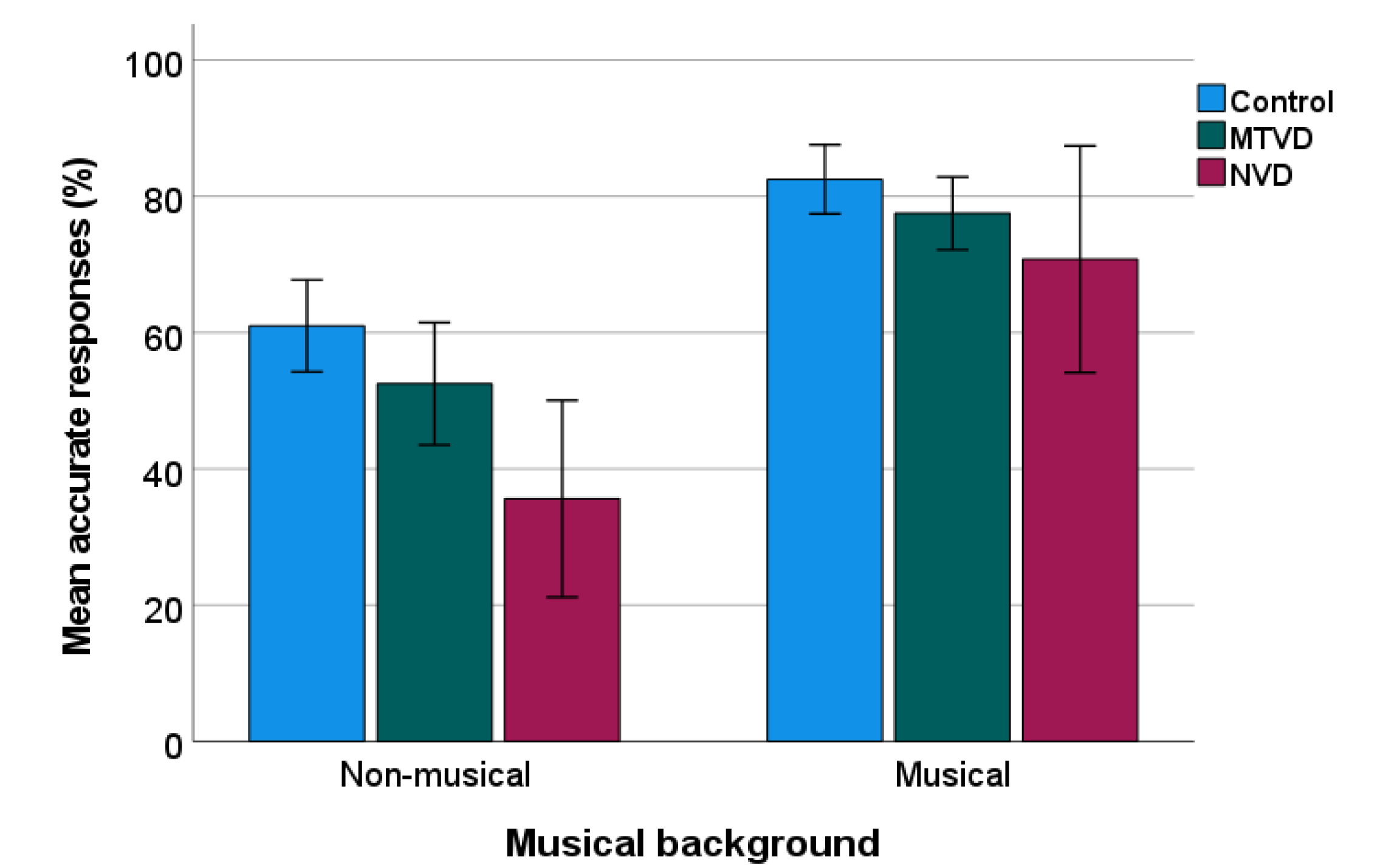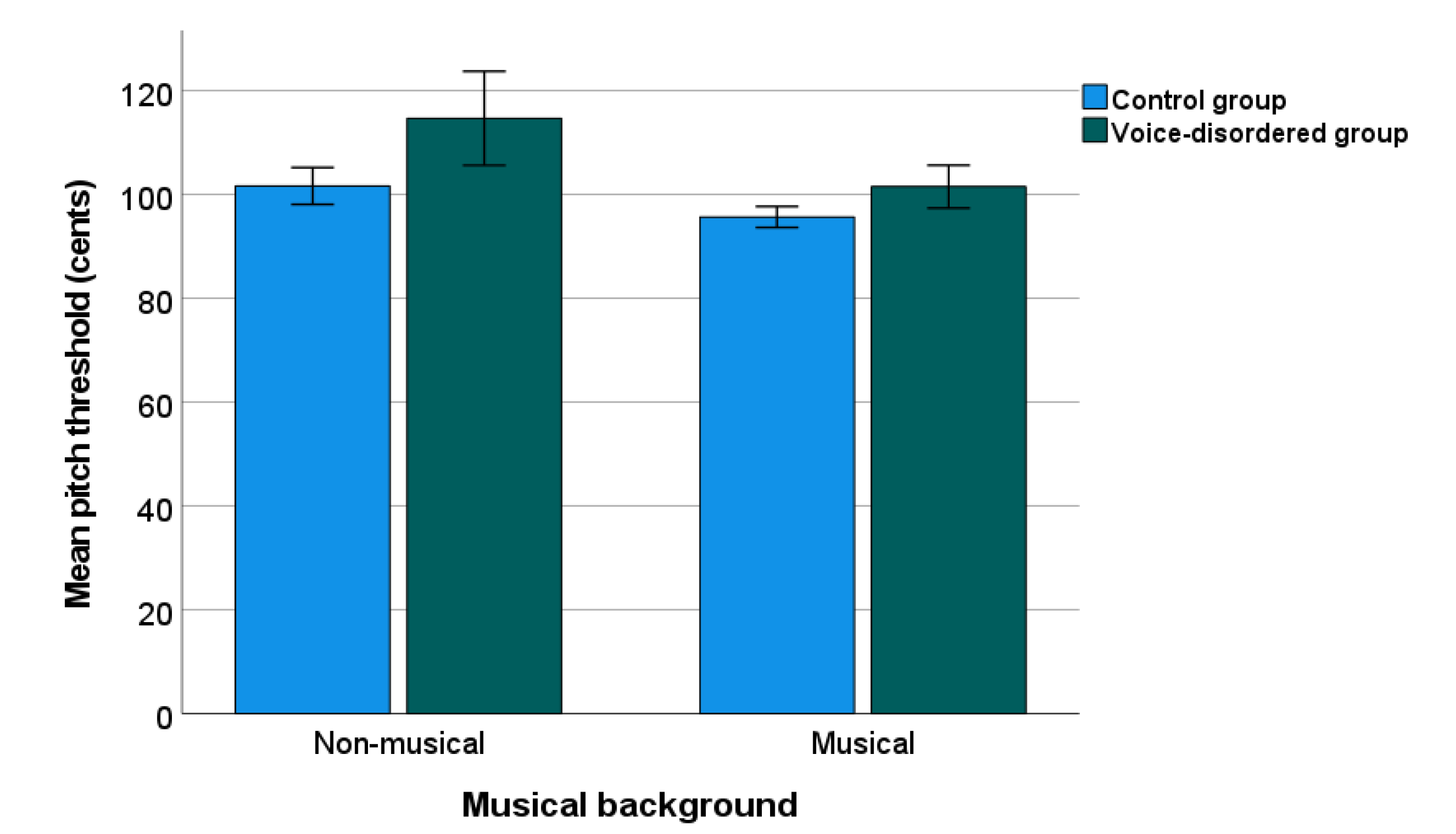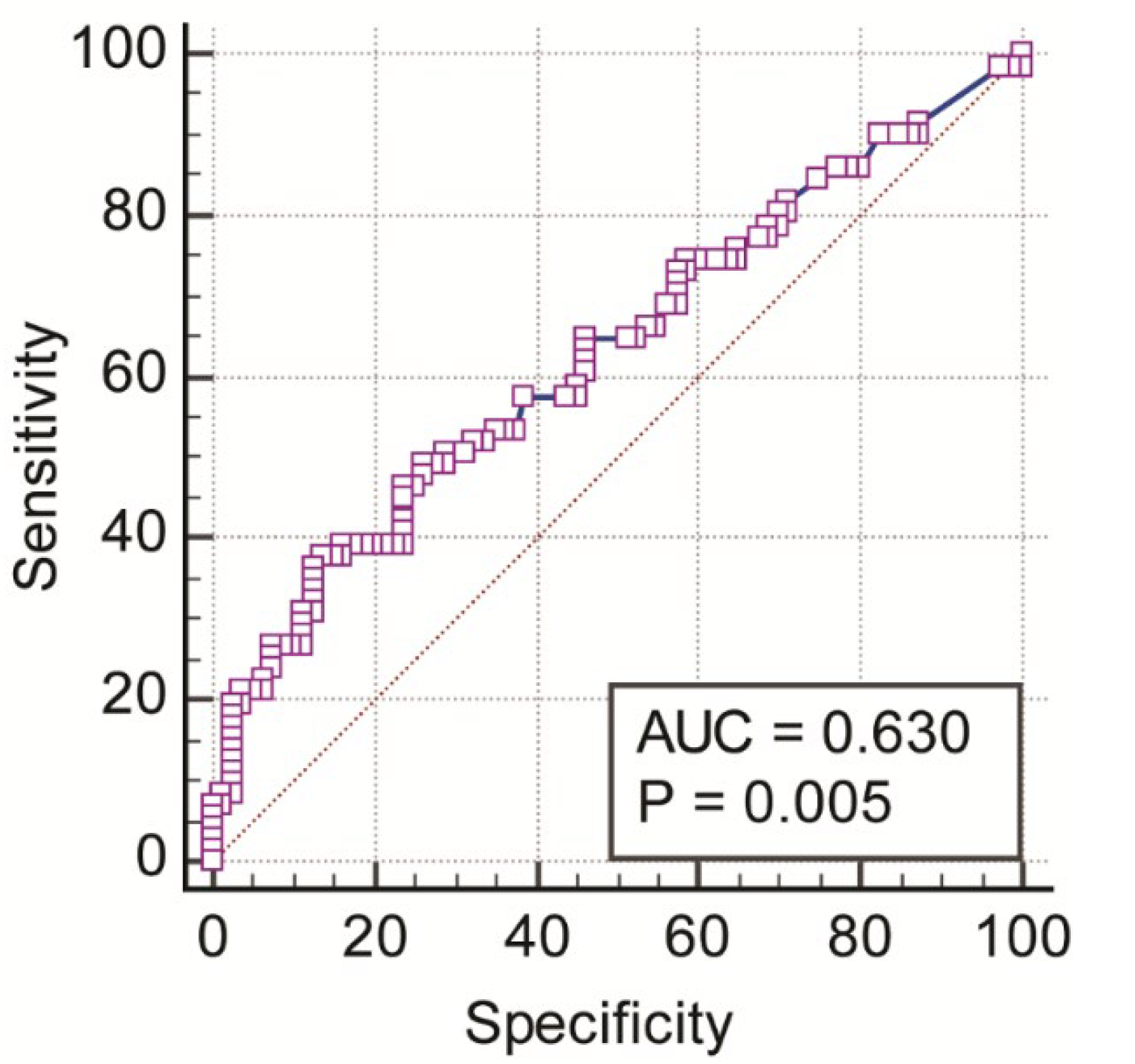Pitch Discrimination Testing in Patients with a Voice Disorder
Abstract
1. Introduction
2. Materials and Methods
2.1. Study Design
2.2. Participants
2.2.1. Voice-Disordered Groups
2.2.2. Control Group
2.3. Voice Assessment
2.4. Pitch Discrimination Testing
2.4.1. Pitch Discrimination Testing Tool
2.4.2. Protocols
2.5. Statistical Analysis
3. Results
3.1. Reliability of PD Testing
3.2. Percentage of Accurate Responses
3.2.1. Voice-Disordered vs. Non-Voice-Disordered Groups
3.2.2. Sub-Group Comparisons
3.3. Pitch Discrimination Threshold
3.3.1. Voice-Disordered vs. Non-Voice-Disordered Groups
3.3.2. Sub-Group Comparisons
3.4. Predictive Value of PD Testing in Differentiating Voice-Disordered from Control Groups
4. Discussion
4.1. Pitch Discrimination in Voice-Disordered Patients
4.2. Predictive Value of PD Testing
5. Conclusions
Author Contributions
Funding
Institutional Review Board Statement
Informed Consent Statement
Data Availability Statement
Acknowledgments
Conflicts of Interest
Appendix A
| Tone Pairs | Frequency 1 (Hz) | Frequency 2 (Hz) | Hz Difference | Cent Difference |
|---|---|---|---|---|
| C3 (130.81) D3(146.83) | 130.81 | 146.83 | 16.02 | 200.01 |
| A3 (220.00) B3 (246.94) | 220 | 246.94 | 26.94 | 199.99 |
| C4 (261.63) D4 (293.66) | 261.63 | 293.66 | 32.03 | 199.94 |
| B2 (123.47) C3 (130.81) | 123.47 | 130.81 | 7.34 | 99.97 |
| E3 (164.81) F3 (174.61) | 164.81 | 174.61 | 9.8 | 100.00 |
| F3 (174.61) F#3 (185.00) | 174.61 | 185 | 10.39 | 100.07 |
| C3 (130.81) C#3 (138.59) | 130.81 | 138.59 | 7.78 | 100.02 |
| G3 (196.00) G#3 (207.65) | 196 | 207.65 | 11.65 | 99.96 |
| D4 (293.66) D#4 (311.13) | 293.66 | 311.13 | 17.47 | 100.04 |
| A3 (220.00) A#3 (233.08) | 220 | 233.08 | 13.08 | 99.99 |
| D4 (293.66) D4.5 (302.26) | 293.66 | 302.26 | 8.6 | 49.97 |
| F3 (174.61) F3.5 (179.73) | 174.61 | 179.73 | 5.12 | 50.03 |
| C3 (130.31) C3.5 (134.64) | 130.31 | 134.64 | 4.33 | 56.59 |
| A3 (220.00) A3.5 (226.45) | 220 | 226.46 | 6.46 | 50.10 |
| E3 (164.81) E3.5 (169.64) | 164.81 | 169.64 | 4.83 | 50.01 |
| D3 (146.83) D3.5 (151.13) | 146.83 | 151.13 | 4.3 | 49.97 |
| B3 (246.94) B3.5 (254.18) | 246.94 | 254.18 | 7.24 | 50.03 |
| G3 (196.00) G3.5 (201.74) | 196 | 201.74 | 5.74 | 49.97 |
| C3 (130.81) C3.3 (133.1) | 130.81 | 133.1 | 2.29 | 30.05 |
| F3 (174.61) F3.3 (177.66) | 174.61 | 177.66 | 3.05 | 29.98 |
References
- Ludlow, C.L. Central nervous system control of the laryngeal muscles in humans. Respir. Physiol. Neurobiol. 2005, 147, 205–222. [Google Scholar] [CrossRef]
- Patel, A.D. Why would Musical Training Benefit the Neural Encoding of Speech? The OPERA Hypothesis. Front. Psychol. 2011, 2, 142. [Google Scholar] [CrossRef]
- Tourville, J.A.; Guenther, F.H. The DIVA model: A neural theory of speech acquisition and production. Lang. Cogn. Process. 2011, 26, 952–981. [Google Scholar] [CrossRef]
- Abur, D.; Subaciute, A.; Kapsner-Smith, M.; Segina, R.K.; Tracy, L.F.; Noordzij, J.P.; Stepp, C.E. Impaired auditory discrimination and auditory-motor integration in hyperfunctional voice disorders. Sci. Rep. 2021, 11, 13123. [Google Scholar] [CrossRef]
- Stepp, C.E.; Lester-Smith, R.A.; Abur, D.; Daliri, A.; Pieter Noordzij, J.; Lupiani, A.A. Evidence for Auditory-Motor Impairment in Individuals with Hyperfunctional Voice Disorders. J. Speech Lang. Hear. Res. 2017, 60, 1545–1550. [Google Scholar] [CrossRef]
- Ramos, J.S.; Feniman, M.R.; Gielow, I.; Silverio, K.C.A. Correlation between Voice and Auditory Processing. J. Voice 2018, 32, 771.e725–771.e736. [Google Scholar] [CrossRef]
- Aronson, A.E.; Bless, D.M. Clinical Voice Disorders, 4th ed.; Thieme: New York, NY, USA, 2009. [Google Scholar]
- Mathieson, L. The Voice and Its Disorders, 6th ed.; Whurr Publishers Ltd.: London, UK, 2001. [Google Scholar]
- Payten, C.; Madill, C. Frameworks, Terminology and Definitions used for the Classification of Voice Disorders: A scoping review. J. Voice, 2021; in press. [Google Scholar]
- Verdolini, K.; Rosen, C.; Branski, R. Classification Manual for Voice Disorders-I; Lawrence Erlbaum Associates, Inc.: Mahwah, NJ, USA, 2006. [Google Scholar]
- Bidelman, G.M.; Hutka, S.; Moreno, S. Tone language speakers and musicians share enhanced perceptual and cognitive abilities for musical pitch: Evidence for bidirectionality between the domains of language and music. PLoS ONE 2013, 8, e60676. [Google Scholar] [CrossRef]
- Micheyl, C.; Delhommeau, K.; Perrot, X.; Oxenham, A.J. Influence of musical and psychoacoustical training on pitch discrimination. Hear. Res. 2006, 219, 36–47. [Google Scholar] [CrossRef]
- Mary Zarate, J.; Ritson, C.R.; Poeppel, D. Pitch-interval discrimination and musical expertise: Is the semitone a perceptual boundary? J. Acoust. Soc. Am. 2012, 132, 984–993. [Google Scholar] [CrossRef]
- Bianchi, F.; Hjortkjaer, J.; Santurette, S.; Zatorre, R.J.; Siebner, H.R.; Dau, T. Subcortical and cortical correlates of pitch discrimination: Evidence for two levels of neuroplasticity in musicians. Neuroimage 2017, 163, 398–412. [Google Scholar] [CrossRef] [PubMed]
- Hall, D.A.; Plack, C.J. Pitch processing sites in the human auditory brain. Cereb. Cortex 2009, 19, 576–585. [Google Scholar] [CrossRef] [PubMed]
- Foxton, J.M.; Weisz, N.; Bauchet-Lecaignard, F.; Delpuech, C.; Bertrand, O. The neural bases underlying pitch processing difficulties. Neuroimage 2009, 45, 1305–1313. [Google Scholar] [CrossRef]
- Behroozmand, R.; Korzyukov, O.; Larson, C.R. ERP correlates of pitch error detection in complex tone and voice auditory feedback with missing fundamental. Brain Res. 2012, 1448, 89–100. [Google Scholar] [CrossRef][Green Version]
- Peretz, I.; Vuvan, D.T. Prevalence of congenital amusia. Eur. J. Hum. Genet. 2017, 25, 625–630. [Google Scholar] [CrossRef]
- Hyde, K.L.; Zatorre, R.J.; Peretz, I. Functional MRI evidence of an abnormal neural network for pitch processing in congenital amusia. Cereb. Cortex 2011, 21, 292–299. [Google Scholar] [CrossRef] [PubMed]
- Anderson, K.S.; Gosselin, N.; Sadikot, A.F.; Lague-Beauvais, M.; Kang, E.S.H.; Fogarty, A.E.; Marcoux, J.; Dagher, J.; de Guise, E. Pitch and Rhythm Perception and Verbal Short-Term Memory in Acute Traumatic Brain Injury. Brain Sci. 2021, 11, 1173. [Google Scholar] [CrossRef]
- Ziethe, A.; Petermann, S.; Hoppe, U.; Greiner, N.; Bruning, M.; Bohr, C.; Dollinger, M. Control of Fundamental Frequency in Dysphonic Patients During Phonation and Speech. J. Voice 2019, 33, 851–859. [Google Scholar] [CrossRef]
- Davis, D.S.; Boone, D.R. Pitch discrimination and tonal memory abilities in adult voice patients. J. Speech Hear. Res. 1967, 10, 811–815. [Google Scholar] [CrossRef]
- Murray, E.S.H.; Hseu, A.F.; Nuss, R.C.; Woodnorth, G.H.; Stepp, C.E. Vocal Pitch Discrimination in Children with and without Vocal Fold Nodules. Appl. Sci. 2019, 9, 3042. [Google Scholar] [CrossRef]
- Thomas, A.; Mirza, N.; Eliades, S.J. Auditory Feedback Control of Vocal Pitch in Spasmodic Dysphonia. Laryngoscope 2021, 131, 2070–2075. [Google Scholar] [CrossRef]
- Naunheim, M.L.; Yung, K.C.; Schneider, S.L.; Henderson-Sabes, J.; Kothare, H.; Hinkley, L.B.; Mizuiri, D.; Klein, D.J.; Houde, J.F.; Nagarajan, S.S.; et al. Cortical networks for speech motor control in unilateral vocal fold paralysis. Laryngoscope 2019, 129, 2125–2130. [Google Scholar] [CrossRef] [PubMed]
- Naunheim, M.L.; Yung, K.C.; Schneider, S.L.; Henderson-Sabes, J.; Kothare, H.; Mizuiri, D.; Klein, D.J.; Houde, J.F.; Nagarajan, S.S.; Cheung, S.W. Vocal motor control and central auditory impairments in unilateral vocal fold paralysis. Laryngoscope 2019, 129, 2112–2117. [Google Scholar] [CrossRef]
- Peretz, I.; Vuvan, D.; Lagrois, M.E.; Armony, J.L. Neural overlap in processing music and speech. Philos. Trans. R. Soc. B Biol. Sci. 2015, 370, 20140090. [Google Scholar] [CrossRef]
- Angulo-Perkins, A.; Concha, L. Discerning the functional networks behind processing of music and speech through human vocalizations. PLoS ONE 2019, 14, e0222796. [Google Scholar] [CrossRef]
- Drinnan, M. Newcastle Assessment of Pitch Discrimination; Newcastle University: Newcastle, UK, 2012. [Google Scholar]
- Yun, E.W.-T.; Nguyen, D.D.; Carding, P.; Hodges, N.J.; Chacon, A.M.; Madill, C. The relationship between pitch discrimination and acoustic voice measures in a cohort of female speakers. J. Voice, 2021; in press. [Google Scholar]
- Rosen, C.A.; Lee, A.S.; Osborne, J.; Zullo, T.; Murry, T. Development and validation of the Voice Handicap Index-10. Laryngoscope 2004, 114, 1549–1556. [Google Scholar] [CrossRef]
- Behlau, M.; Madazio, G.; Moreti, F.; Oliveira, G.; Dos Santos Lde, M.; Paulinelli, B.R.; Couto Junior Ede, B. Efficiency and Cutoff Values of Self-Assessment Instruments on the Impact of a Voice Problem. J. Voice 2016, 30, 506.e509–506.e518. [Google Scholar] [CrossRef]
- Kempster, G.B.; Gerratt, B.R.; Verdolini Abbott, K.; Barkmeier-Kraemer, J.; Hillman, R.E. Consensus auditory-perceptual evaluation of voice: Development of a standardized clinical protocol. Am. J. Speech Lang. Pathol. 2009, 18, 124–132. [Google Scholar] [CrossRef]
- Fairbanks, G. Voice and Articulation Drillbook, 2nd ed.; Harper & Row: New York, NY, USA, 1960. [Google Scholar]
- Awan, S.N.; Roy, N.; Jette, M.E.; Meltzner, G.S.; Hillman, R.E. Quantifying dysphonia severity using a spectral/cepstral-based acoustic index: Comparisons with auditory-perceptual judgements from the CAPE-V. Clin. Linguist. Phon. 2010, 24, 742–758. [Google Scholar] [CrossRef]
- Awan, S.N.; Roy, N.; Zhang, D.; Cohen, S.M. Validation of the Cepstral Spectral Index of Dysphonia (CSID) as a Screening Tool for Voice Disorders: Development of Clinical Cutoff Scores. J. Voice 2016, 30, 130–144. [Google Scholar] [CrossRef] [PubMed]
- Boersma, P.; Weenink, D. Praat: Doing Phonetics by Computer. Available online: http://www.fon.hum.uva.nl/praat/ (accessed on 26 January 2018).
- IBM Corp. IBM SPSS Software. Available online: https://www.ibm.com/analytics/data-science/predictive-analytics/spss-statistical-software (accessed on 8 February 2018).
- MedCalc Software. MedCalc—User-Friendly Statistical Software. Available online: https://www.medcalc.org/ (accessed on 15 September 2021).
- Shrout, P.E.; Fleiss, J.L. Intraclass correlations: Uses in assessing rater reliability. Psychol. Bull. 1979, 86, 420–428. [Google Scholar] [CrossRef] [PubMed]
- Koo, T.K.; Li, M.Y. A Guideline of Selecting and Reporting Intraclass Correlation Coefficients for Reliability Research. J. Chiropr. Med. 2016, 15, 155–163. [Google Scholar] [CrossRef] [PubMed]
- Murphy, K.R. Statistical Power Analysis: A Simple and General Model for Traditional and Modern Hypothesis Tests, 4th ed.; Routledge: New York, NY, USA, 2014. [Google Scholar]
- Zarate, J.M.; Delhommeau, K.; Wood, S.; Zatorre, R.J. Vocal accuracy and neural plasticity following micromelody-discrimination training. PLoS ONE 2010, 5, e11181. [Google Scholar] [CrossRef]
- Morrison, M.; Rammage, L.; Emami, A.J. The irritable larynx syndrome. J. Voice 1999, 13, 447–455. [Google Scholar] [CrossRef]
- Vertigan, A.E.; Bone, S.L.; Gibson, P.G. Laryngeal sensory dysfunction in laryngeal hypersensitivity syndrome. Respirology 2013, 18, 948–956. [Google Scholar] [CrossRef]
- Patel, S.; Gao, L.; Wang, S.; Gou, C.; Manes, J.; Robin, D.A.; Larson, C.R. Comparison of volitional opposing and following responses across speakers with different vocal histories. J. Acoust. Soc. Am. 2019, 146, 4244. [Google Scholar] [CrossRef]
- Kim, J.H.; Larson, C.R. Modulation of auditory-vocal feedback control due to planned changes in voice fo. J. Acoust. Soc. Am. 2019, 145, 1482. [Google Scholar] [CrossRef]
- McDermott, J.H.; Keebler, M.V.; Micheyl, C.; Oxenham, A.J. Musical intervals and relative pitch: Frequency resolution, not interval resolution, is special. J. Acoust. Soc. Am. 2010, 128, 1943–1951. [Google Scholar] [CrossRef]





| Groups | Musical Background | Total | |
|---|---|---|---|
| No | Yes | ||
| Control | 40 | 40 | 80 |
| MTVD no lesions | 7 | 19 | 26 |
| MTVD with lesions | 11 | 13 | 24 |
| Neurological dysphonia | 8 | 13 | 21 |
| Total | 66 | 85 | 151 |
| Measures (Normative Values) | Voice-Disordered Group | Control (n = 80) | p | ||
|---|---|---|---|---|---|
| MTVD (n = 50) | Neurological Voice Disorders (n = 21) | All (n = 71) | |||
| HNR (dB) (20 dB) [37] | 23.90 (4.16) 22.71–25.10 | 21.36 (7.80) 17.81–24.91 | 23.14 (5.57) 21.81–24.47 | 24.90 (2.46) 24.35–25.45 | 0.016 |
| CSID of vowel (NA) | 9.03 (18.17) 3.81–14.25 | 25.43 (31.79) 10.96–39.90 | 13.95 (24.08) 8.21–19.69 | −10.81 (7.38) (−12.45)–(−9.17) | <0.001 |
| CSID of CAPEV-3 (NA) | −10.18 (20.78) (−16.15)–(−4.21) | 1.42 (30.05) (−12.26)–15.10 | −6.70 (24.31) (−12.49)–(−0.90) | −16.36 (9.48) (−18.47)–(−14.25) | <0.001 |
| CSID Rainbow Passage (24.27) [36] | 17.49 (14.05) 13.45–21.52 | 21.13 (17.84) 13.01–29.25 | 18.58 (15.24) 14.95–22.21 | −3.16 (19.19) (−7.43)–1.12 | <0.001 |
| Groups | Single Measures (ICC, 95% CI) | Average Measures (ICC, 95% CI) | p |
|---|---|---|---|
| Whole cohort | 0.899 (0.863–0.926) | 0.947 (0.927–0.961) | <0.001 |
| Control (n = 80) | 0.880 (0.819–0.921) | 0.936 (0.901–0.959) | <0.001 |
| MTVD (n = 50) | 0.847 (0.746–0.910) | 0.917 (0.854–0.953) | <0.001 |
| Neuro (n = 21) | 0.972 (0.933–0.989) | 0.986 (0.965–0.994) | <0.0001 |
Publisher’s Note: MDPI stays neutral with regard to jurisdictional claims in published maps and institutional affiliations. |
© 2022 by the authors. Licensee MDPI, Basel, Switzerland. This article is an open access article distributed under the terms and conditions of the Creative Commons Attribution (CC BY) license (https://creativecommons.org/licenses/by/4.0/).
Share and Cite
Nguyen, D.D.; Chacon, A.M.; Novakovic, D.; Hodges, N.J.; Carding, P.N.; Madill, C. Pitch Discrimination Testing in Patients with a Voice Disorder. J. Clin. Med. 2022, 11, 584. https://doi.org/10.3390/jcm11030584
Nguyen DD, Chacon AM, Novakovic D, Hodges NJ, Carding PN, Madill C. Pitch Discrimination Testing in Patients with a Voice Disorder. Journal of Clinical Medicine. 2022; 11(3):584. https://doi.org/10.3390/jcm11030584
Chicago/Turabian StyleNguyen, Duy Duong, Antonia M. Chacon, Daniel Novakovic, Nicola J. Hodges, Paul N. Carding, and Catherine Madill. 2022. "Pitch Discrimination Testing in Patients with a Voice Disorder" Journal of Clinical Medicine 11, no. 3: 584. https://doi.org/10.3390/jcm11030584
APA StyleNguyen, D. D., Chacon, A. M., Novakovic, D., Hodges, N. J., Carding, P. N., & Madill, C. (2022). Pitch Discrimination Testing in Patients with a Voice Disorder. Journal of Clinical Medicine, 11(3), 584. https://doi.org/10.3390/jcm11030584






